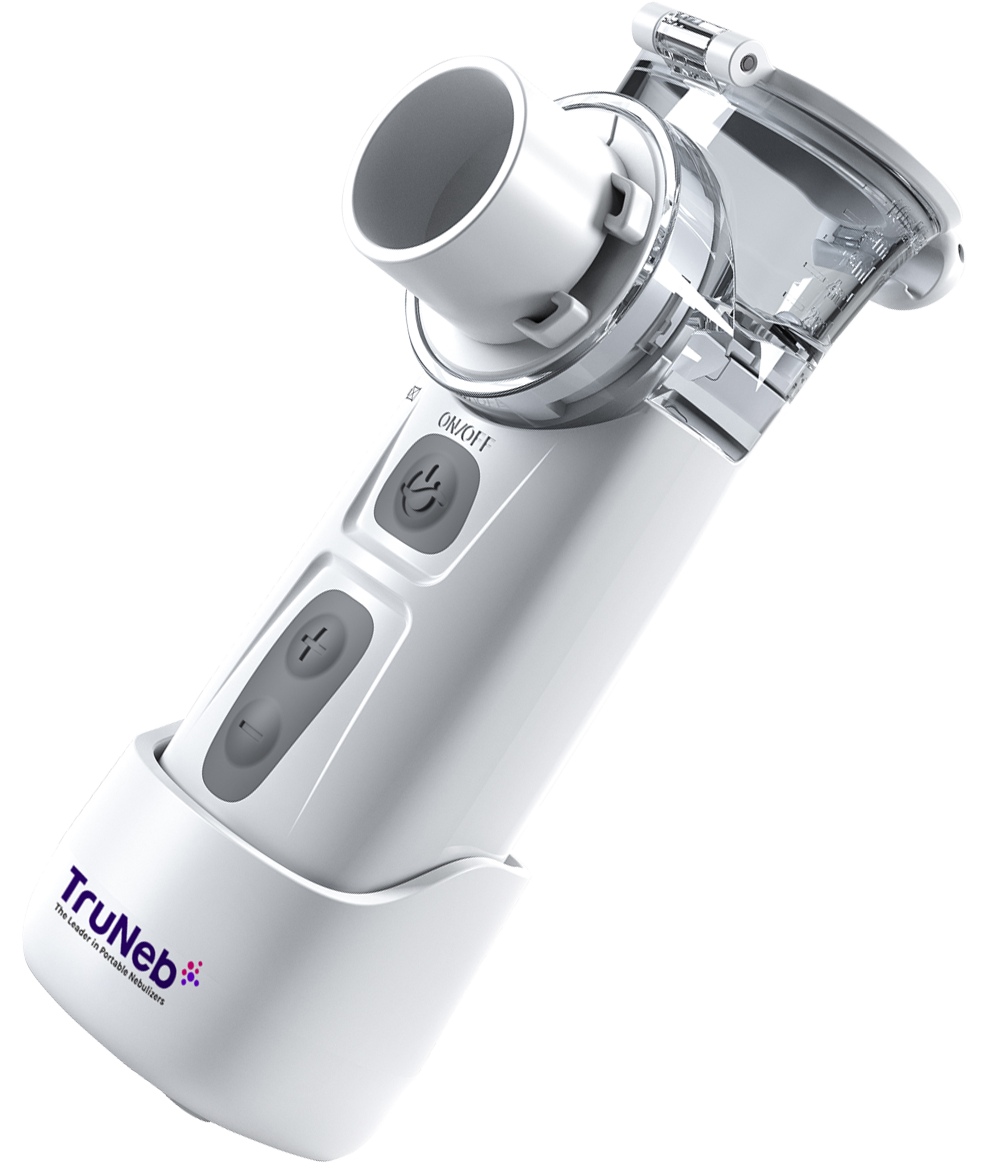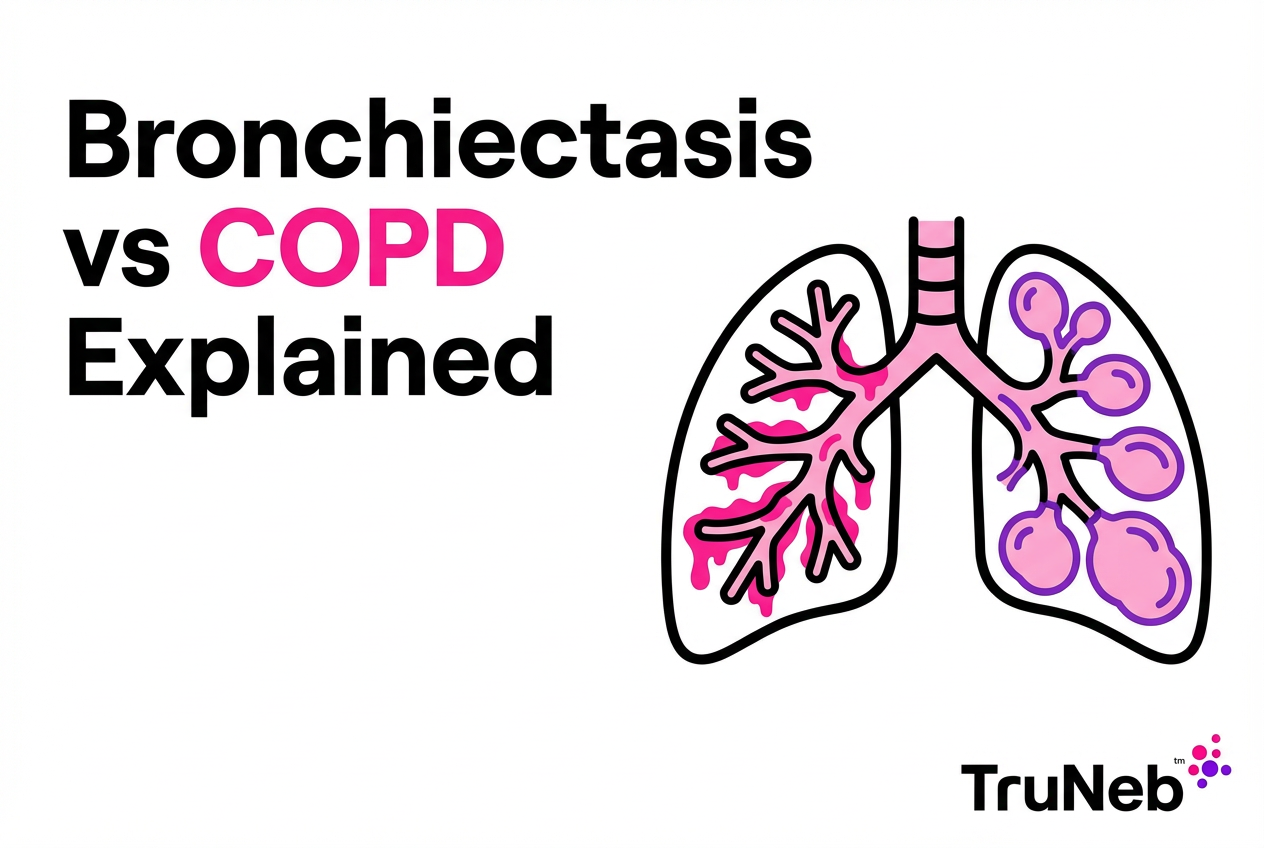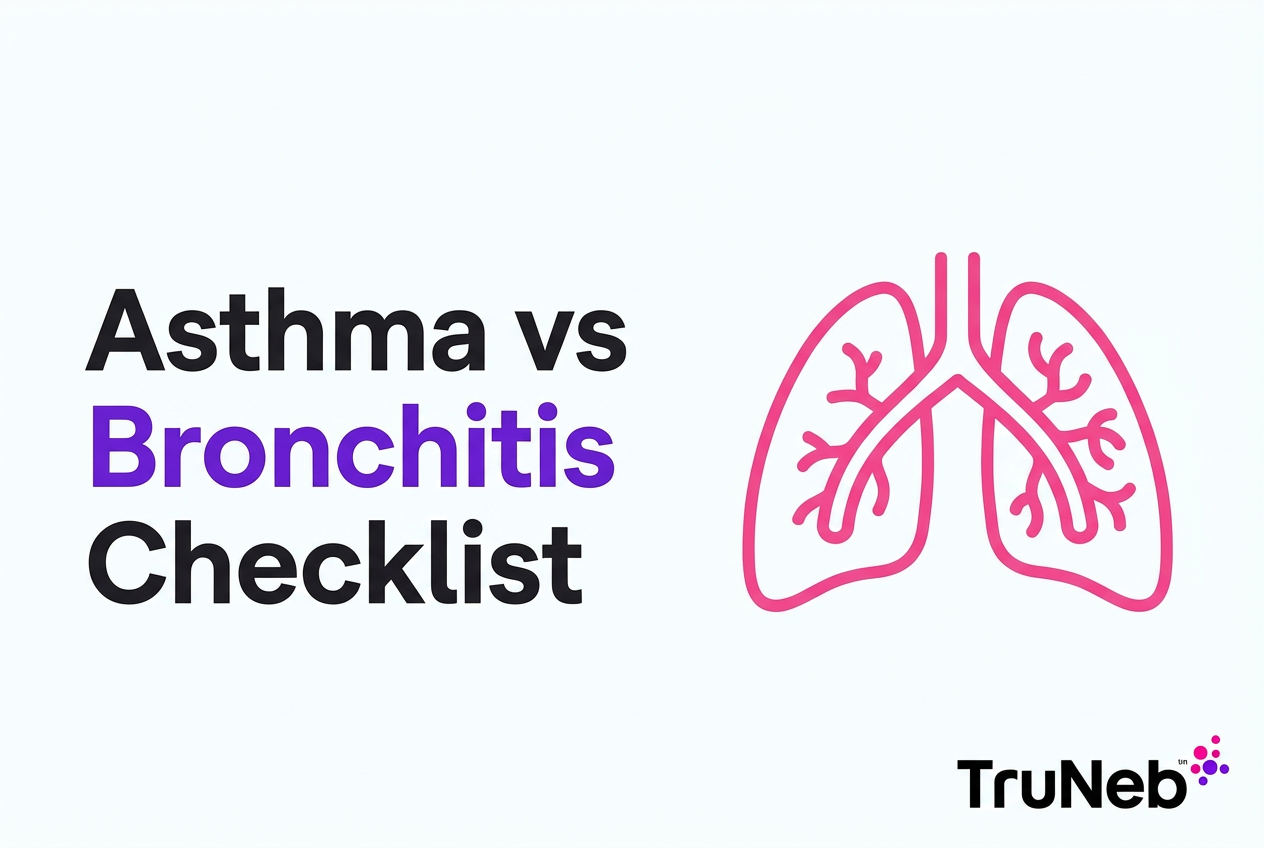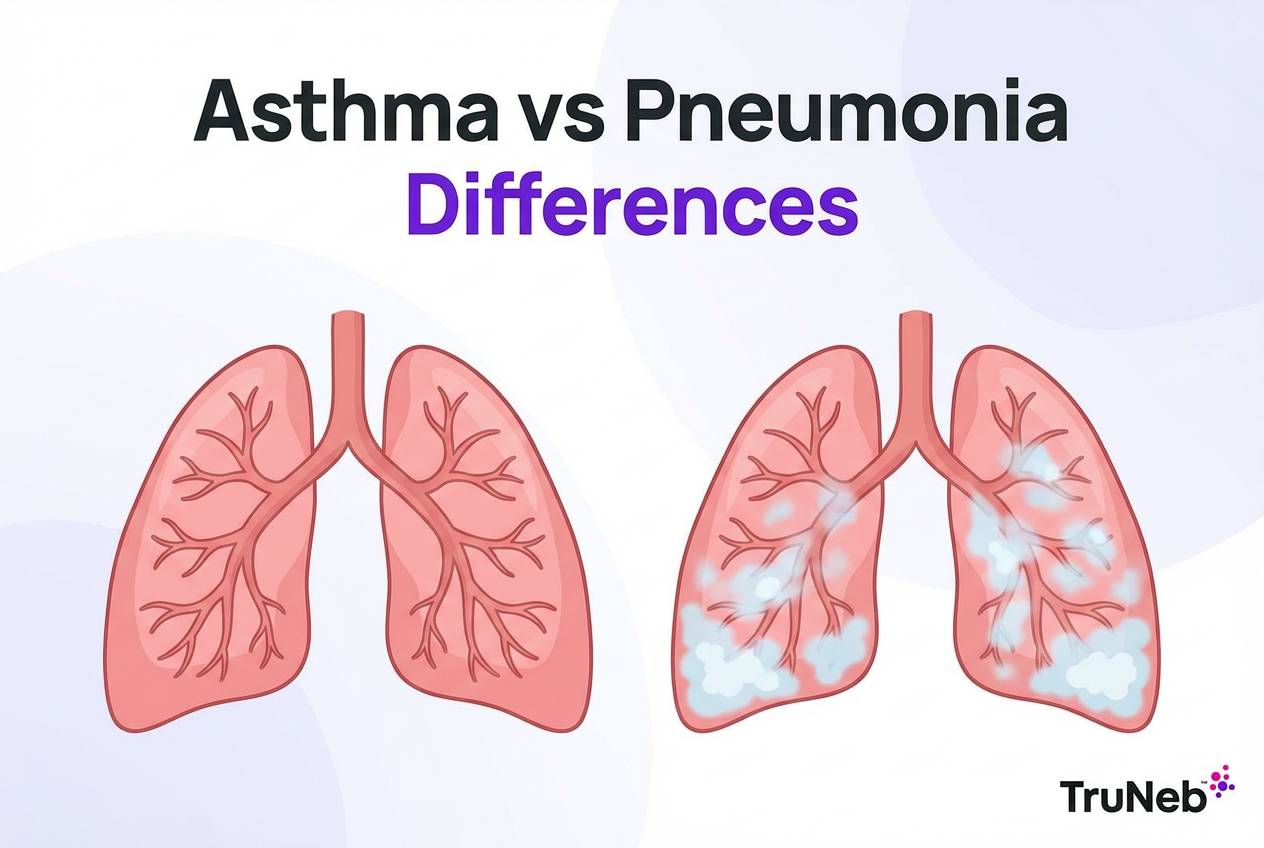On this page
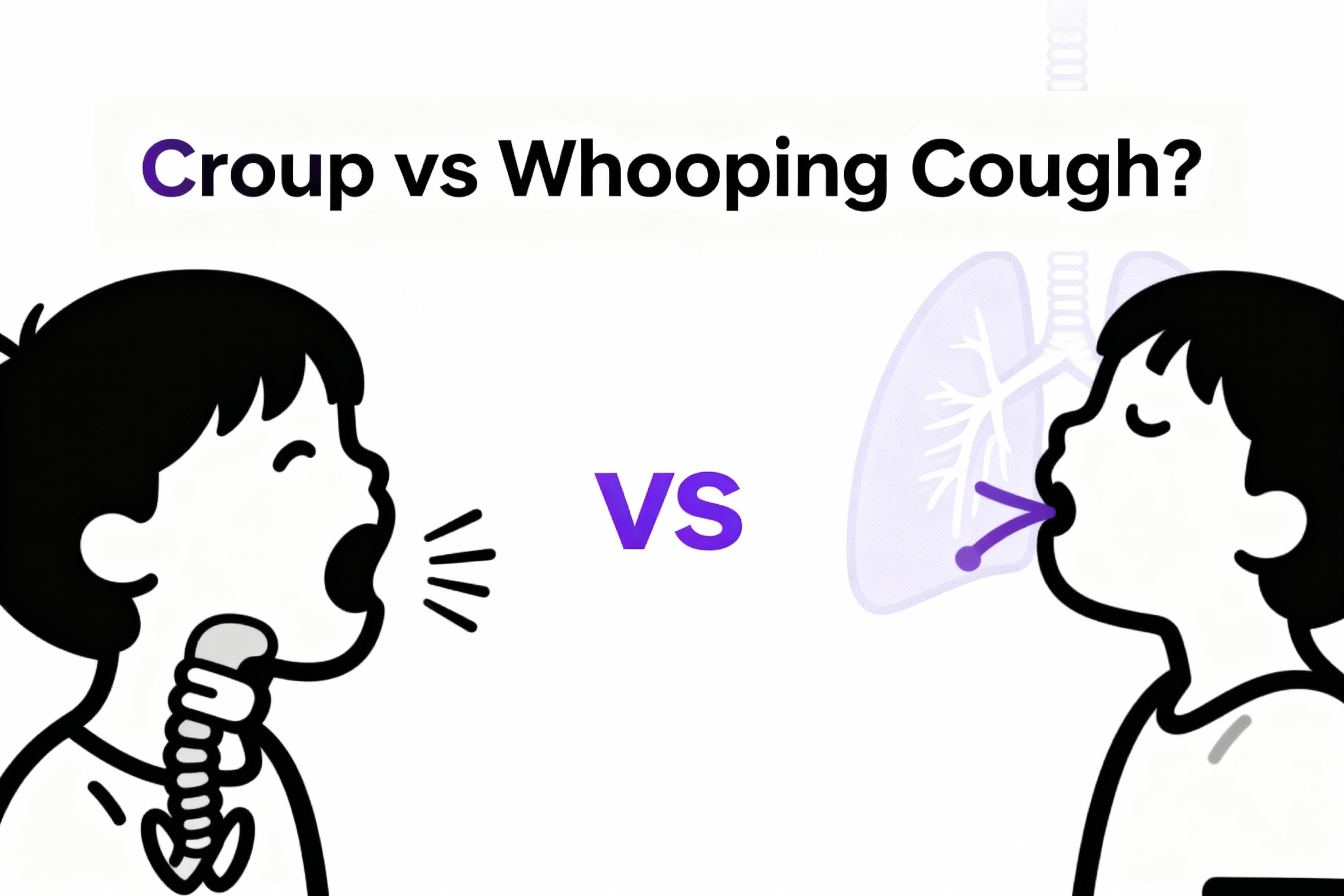
Croup vs Whooping Cough: Are They the Same Illness?
Rule of thumb: Croup is a short viral bark, and whooping cough is a long bacterial whoop.
Croup vs whooping cough can be confusing because both can start out looking like a regular cold.
But croup and whooping cough are not the same illness.
Croup is a viral infection of the upper airway (sometimes called laryngotracheitis) that causes swelling around the voice box (larynx) and windpipe (trachea). That swelling narrows the upper airway and leads to a hoarse, barking cough.
Whooping cough, also called pertussis, is a bacterial infection caused by a germ named Bordetella pertussis. It irritates the breathing tubes and triggers long, forceful coughing fits that can end with a loud "whoop" when your child gasps for air.
Croup is most common in toddlers, while whooping cough can affect all ages but is especially dangerous for young babies.
Understanding the difference between croup and whooping cough helps you and your pediatrician choose the safest care and watch for the right warning signs.
Croup vs Whooping Cough: Causes and How They Spread
Quick definition: Croup is caused by viruses, while whooping cough is caused by a single bacterium called Bordetella pertussis.
Croup causes
Croup is almost always caused by viruses. The most common is parainfluenza virus. Other cold viruses like RSV and influenza can cause it too.
These viruses spread through tiny droplets when someone coughs, sneezes, or talks. Kids commonly pick them up at daycare, school, or from sick siblings. Croup is most common between 6 months and 3 years of age and tends to appear in the fall and winter.
Because croup is viral:
- Antibiotics do not treat it.
- There is no specific "croup vaccine."
Whooping cough causes
Whooping cough (pertussis) has a very different cause. It comes from one bacterium, Bordetella pertussis.
This germ is highly contagious. It spreads through the air when an infected person coughs or sneezes, and it can move quickly through homes, schools, and daycare centers.
Because whooping cough is bacterial:
- Antibiotics can help, especially early on.
- There is a vaccine that helps prevent severe disease.
Both illnesses spread easily in close contact, so handwashing, covering coughs, and keeping sick kids home are simple steps that can really lower the chance of spread.
So croup is a viral illness spread like a cold, while whooping cough is a bacterial illness that spreads very easily in close contact.
Croup vs Whooping Cough Symptoms and Cough Sounds
Easiest way to tell: croup sounds like a barking seal, whooping cough sounds like a gasping whoop after many coughs in a row.
If you're trying to sort out croup vs whooping cough symptoms or a barking cough vs whooping cough, the cough sound is one of the clearest clues.
Typical croup symptoms
- Barking, seal-like cough that usually starts or worsens at night
- Hoarse or raspy voice
- Noisy breathing in, called stridor, especially when your child is crying or upset
- Stuffy nose and mild fever, like a regular cold
- Symptoms typically come on suddenly after a day or two of runny nose
A lot of parents say the croup cough sounds like a small dog or seal barking.
Typical whooping cough (pertussis) symptoms
- Coughing fits (paroxysms) where your child coughs over and over without catching a breath
- A loud "whoop" sound when they finally breathe in after a spell (young babies sometimes don't whoop at all)
- Possible vomiting or gagging after a hard coughing fit
- Face that turns red or even slightly blue during the spell
- Very little or no fever after the first cold-like week
Between coughing spells, children with whooping cough can look okay and breathe quietly, then suddenly have another long fit.
Barking cough vs whooping cough at a glance
Here is a simple way to compare the difference between croup and whooping cough symptoms:
| Feature | Croup | Whooping cough (pertussis) |
|---|---|---|
| Cough sound | Barking, seal-like cough | Series of strong coughs, then a gasping whoop |
| Voice | Hoarse or raspy | Usually normal between coughing fits |
| Breathing between coughs | Noisy breathing in (stridor), especially at night | Breathing is usually quiet between spells; trouble is worst during fits |
| Fever | Mild or none | Mild at first, then usually no fever |
| Other signs | Often worse at night; may seem better with cool air or steam | Fits can cause vomiting, exhaustion, or brief pauses in breathing in infants |
*Babies with pertussis may not make a clear “whoop” sound, so any repeated coughing spells or pauses in breathing should be checked by a doctor.
Early on, both illnesses can look alike: runny nose, mild cough, maybe a low fever. As days pass, croup tends to stay barky and short-lived, while pertussis keeps building into stronger, longer coughing spells.
That pattern is a big clue when you are trying to figure out how to tell croup from whooping cough.
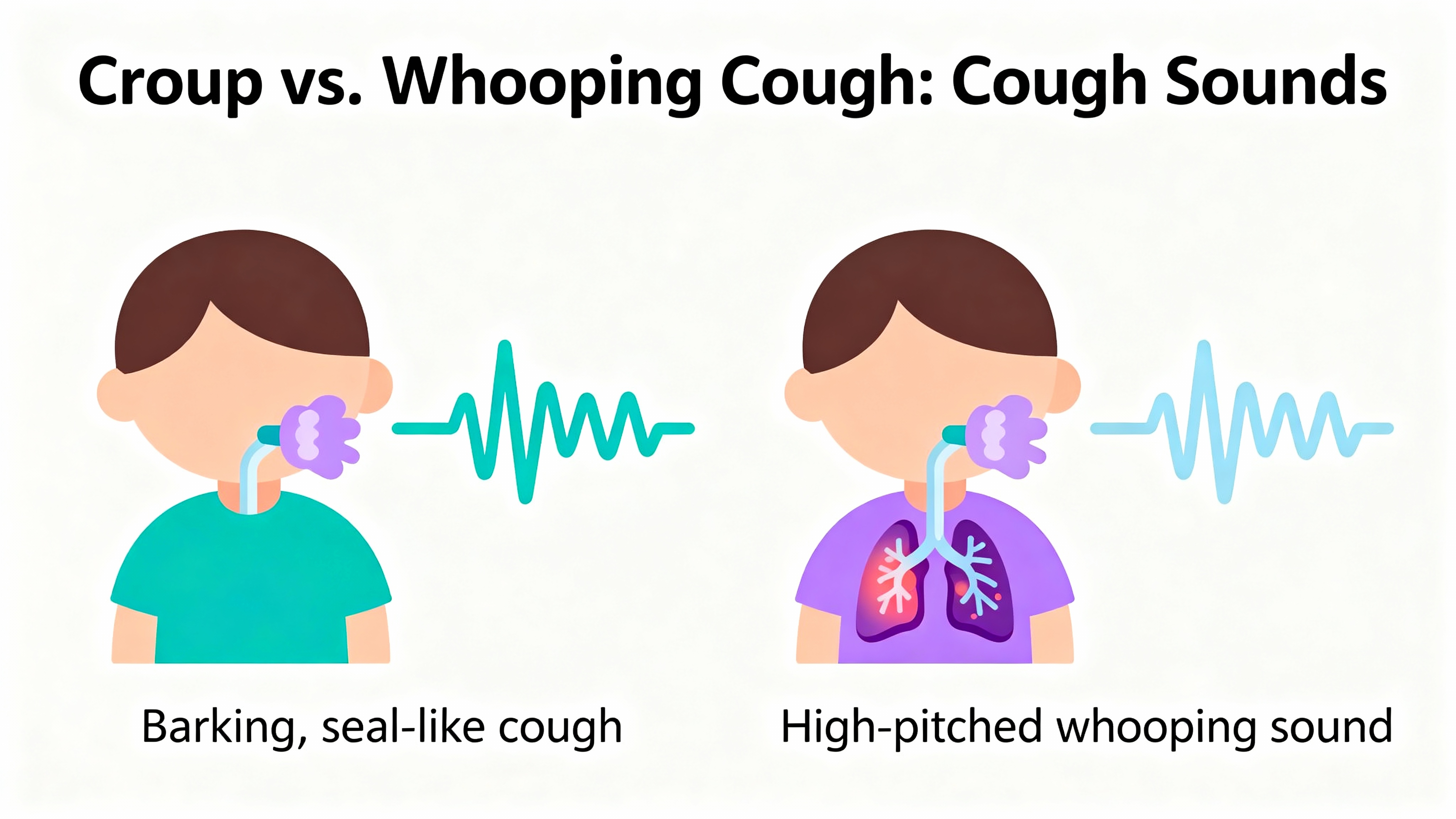
How Long Croup vs Whooping Cough Lasts and How Severe They Get
Think "short and sharp" for croup, and "long and draining" for whooping cough.
Croup usually lasts a few days to about a week, while whooping cough can cause severe coughing spells for six weeks or longer.
Croup duration and severity
Croup is usually a short illness.
- Symptoms usually peak over the first 2 to 3 nights.
- Most children feel much better within 3 to 7 days.
- A mild dry cough can linger a bit longer.
Most croup is mild to moderate. Serious problems are less common but can include:
- Trouble breathing from airway swelling
- Need for oxygen or a brief hospital stay
Once croup is over, children usually recover fully with no lasting lung damage.
Whooping cough duration and severity
Whooping cough lasts much longer. People sometimes call it the "100-day cough" because it can drag on for weeks.
Doctors describe three stages:
- First stage (1–2 weeks): Runny nose, mild cough, maybe a low fever. It looks like a regular cold.
- Coughing stage (2–6+ weeks): Strong, repeated coughing fits, sometimes with a whoop and vomiting.
- Recovery stage (weeks): Cough slowly fades but can flare again with new colds.
Pertussis can cause:
- Pneumonia
- Weight loss or dehydration from poor feeding
- Rib pain or even rib fractures in older kids or adults from severe coughing
Babies, especially under 6 months, are at the highest risk. About half of babies with whooping cough need hospital care.
So for croup vs pertussis in toddlers and young children, croup usually brings a dramatic but brief barking illness, while whooping cough brings week after week of tiring coughing spells and can be truly dangerous for infants.
Treating Croup vs Whooping Cough: Home Care, Medicines, and Nebulizers
Key idea: Croup treatment focuses on easing swelling and noise, while whooping cough treatment focuses on antibiotics and careful support over time.
Always work with your pediatrician when treating croup vs whooping cough. Here is what care usually looks like.
Croup care
For mild croup, doctors usually suggest simple home steps:
- Keeping your child calm and close, since crying can make noisy breathing worse
- Using cool mist from a humidifier in the bedroom
- Offering plenty of fluids so your child stays hydrated
- Noticing that stepping outside into cool night air sometimes seems to ease the barky cough for a short time
Doctors commonly give a single dose of a steroid medicine, such as dexamethasone, to shrink swelling in the upper airway. In more serious cases, the emergency team can use a nebulized epinephrine treatment to quickly open the airway while the steroid starts to work.
Over-the-counter cough syrups are not helpful for croup and are not safe for young children.
You can read more about how nebulizer treatments help breathing problems in this guide to the best nebulizer for COPD.
Whooping cough care
Whooping cough always needs medical care.
- Doctors usually prescribe an antibiotic, such as azithromycin, to kill the pertussis bacteria and lower the chance of spreading it. Antibiotics work best early in the illness and mainly help reduce complications and the chance of spreading the infection.
- The cough can still last for weeks, but early antibiotics can make the illness less severe and protect people around your child.
- Close contacts, like parents or siblings, sometimes also need preventive antibiotics.
Children with whooping cough sometimes need to be in the hospital for:
- Oxygen and careful monitoring
- Help with feeding and fluids
- Watching for pauses in breathing
Older children can usually stay home but need small, frequent meals, rest, and time to recover between coughing spells.
Cough suppressants usually do not help with pertussis, and they can be unsafe in young kids. A spoonful of honey can soothe the throat for children older than 1 year.
Children with whooping cough usually need to stay home from school or daycare until they have taken antibiotics for several days and your doctor says they are no longer contagious.
Nebulizers, saline, and TruNeb™ portable mesh nebulizer
Nebulizers turn liquid medicine or saline into a fine mist that is easy to breathe in. Nebulizers don't cure croup or whooping cough on their own. They help deliver medicines or saline that your child's doctor has prescribed.
Doctors sometimes use them for:
- Epinephrine or steroids in more serious croup
- Bronchodilators if a child also has asthma or wheezing
- Saline to help loosen thick mucus
A portable mesh device like the TruNeb™ portable mesh nebulizer can make these breathing treatments easier. It is small, quiet, and handheld, so a child can use it on the couch, in bed, or while traveling. You can see how it works here: TruNeb portable mesh nebulizer.
You might also see products labeled as steam inhalers. These are different from nebulizers and are not meant for breathing prescription medications. Only use your nebulizer with medicines or saline your child's doctor recommends.
Some doctors also recommend nebulized saline to help loosen sticky mucus. Hypertonic saline is a saltwater solution that is stronger than the normal body salt level. TruNeb offers sterile 3% and 7% hypertonic saline made in an FDA-approved lab in single-use vials, such as this 3% hypertonic saline solution. Only use hypertonic saline if your child's doctor has specifically recommended it for your child. You can learn more about how it works in this article on hypertonic saline for bronchiolitis.
Always follow your pediatrician's instructions for nebulizer use, antibiotics, and steroid medicines. Talk to your doctor before trying a new medication, changing doses, or starting hypertonic saline on your own.
Preventing Croup vs Whooping Cough: Vaccines and Everyday Habits
Short answer: you can't vaccinate against croup, but you can strongly lower whooping cough risk with DTaP and Tdap shots.
Preventing croup
There is no vaccine for croup. Several different viruses can cause it, so a single shot cannot cover them all.
You can still lower your child's risk with simple steps:
- Teach regular handwashing with soap and water.
- Keep your child away from people who are coughing or have fevers when possible.
- Clean shared toys and surfaces.
- Keep your child home from school or daycare when they are sick.
Even with good habits, most young kids will get croup at least once. The goal is to catch symptoms early and manage them safely.
Preventing whooping cough (pertussis)
Whooping cough does have a vaccine.
- Babies and young children get a series of DTaP shots in the first years of life.
- Older kids, teens, and adults get Tdap booster shots to keep protection strong.
- Pregnant people are advised to get Tdap during each pregnancy so they can pass antibodies to the baby.
Protection from pertussis can fade over time, which is why booster shots like Tdap are important for older kids and adults.
These vaccines do not always prevent infection completely, but they make whooping cough milder and lower the risk of hospital care or death, especially in infants.
Because pertussis is so contagious, keeping everyone in the home up to date on Tdap and DTaP is one of the best ways to protect fragile babies.
Croup vs Whooping Cough: When to Call the Doctor or Go to the ER
Safety rule: any trouble breathing, color change, or pause in breathing with a cough illness is an emergency.
Knowing when to seek medical help matters even more than knowing the exact name of the illness.
Call your child's doctor soon if:
- Your child has a barky cough or coughing fits that are not improving after a day or two.
- You think your child was exposed to someone with whooping cough.
- A baby under 1 year has any unusual or repeated cough.
- Your child has a cough illness and other health problems like heart disease or chronic lung disease.
⚠️ If your child has trouble breathing, changes color, or pauses breathing, treat it as an emergency and seek care right away.
Get urgent or emergency help right away (call 911 in the U.S.) if your child has:
- Struggling to breathe, with chest pulling in between or under the ribs
- Loud, harsh breathing noise at rest, not just when crying
- Blue, gray, or very pale lips, face, or tongue
- Drooling or trouble swallowing
- Pauses in breathing (apnea), especially in young babies
- Signs of dehydration, such as very few wet diapers, no tears when crying, or a dry mouth
- Coughing so hard that your child cannot catch a breath or is getting weaker
Doctors and nurses would rather see your child early than have you wait at home and worry. If something does not feel right, trust your instincts and get help.
Croup vs Whooping Cough: Key Takeaways and Quick Answers
Bottom line: croup is a short viral bark; whooping cough is a long bacterial whoop that needs antibiotics and careful follow-up.
Big picture
- Croup is a viral illness of the upper airway that causes a barking cough and hoarse voice.
- Whooping cough (pertussis) is a bacterial infection that causes long coughing fits and a whooping sound when breathing in.
- Croup is usually short and scary-sounding but mild.
- Pertussis can last for weeks and is especially dangerous for young babies.
In short, the difference between croup and whooping cough comes down to cause (virus vs bacteria), cough sound (bark vs whoop), and how long the illness lasts.
Understanding these differences helps you know what questions to ask your child's doctor.
Frequently Asked Questions
Tap or click a question below to see the answer:
No. Croup is a viral infection of the upper airway that causes a barky, seal-like cough, while whooping cough (pertussis) is a bacterial infection that causes long coughing fits and sometimes a gasping “whoop.” They have different causes, treatments, and prevention.
Croup usually causes a sudden, barky cough and noisy breathing in, often worse at night, and tends to peak over 2–3 nights. Whooping cough starts like a cold, then turns into repeated coughing fits that may end with a “whoop” or vomiting and can go on for weeks. Only a clinician can diagnose for sure, so call your child’s doctor if you’re unsure.
Both can be serious, but whooping cough is generally more dangerous, especially for babies under 6 months, who often need hospital care. Most croup in toddlers is short-lived and can be managed with home care and a steroid dose from the doctor, though any trouble breathing is an emergency for either illness.
No. A barking cough is classic for croup, but other problems that affect the voice box and upper airway can sound similar. Any child with a sudden harsh cough, noisy breathing, or trouble catching their breath should be checked by a doctor.
No. Young infants may have pauses in breathing instead of a clear whoop, and vaccinated older kids or adults may just have a stubborn, hacking cough. Long, repeated coughing fits that cause vomiting, color change, or exhaustion are a reason to see a doctor, even without an obvious whoop.
Adults rarely get classic croup because their airways are larger, but they can get laryngitis and bad coughs from the same viruses. Adults and teens can definitely get whooping cough, especially if it has been many years since their last Tdap booster, and they can spread it to babies.
RSV, flu, asthma, pneumonia, and COVID-19 can all cause hard or noisy breathing and bad coughs. These usually cause wheezing, fast breathing, or lung congestion rather than a classic bark or whoop. Any severe cough with trouble breathing, color change, or poor feeding should be seen urgently.
How TruNeb fits in
Tools like a portable nebulizer can be part of the plan when your child's doctor recommends breathing treatments. A quiet device like the TruNeb™ portable mesh nebulizer makes doctor-prescribed treatments easier to fit into daily life at home or on the go.
TruNeb is designed to make breathing treatments fit into real life, not take it over. It pairs well with doctor-prescribed medicines or sterile saline when those are part of your child's care plan.
Disclaimer: This article is for informational purposes only and is not a substitute for professional medical advice. Always talk to your child's doctor about concerns, new symptoms, or changes to treatments, including nebulizer use or new medications.

